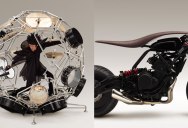Yamaha Design Teams Swap Roles, Build Crazy Versions of Each Other’s Products
Yamaha is a multinational conglomerate that makes a broad range of products, from pianos to motorcycles. In a project entitled AH A MAY (Yamaha backwards), design teams from the musical instrument and motor vehicle divisions swapped roles, designing products for each other. Four actual prototypes were built and presented as a joint exhibit at the Ninth Edition of the Biennale Internationale Design Saint-Etienne 2015.
Yamaha explains:
The theme of the exhibit will be “project AH A MAY.” In preparing for this project, the design divisions of the two Yamahas exchanged their design fields, and, without any constraints related to production or commercialization, created designs according to each Yamaha’s method and way of thinking. These two Yamahas went about designing these products with the understanding that their products would be mirror images of one another. The goal of this project is for the designers to stimulate each other’s imaginations and seek to create products that embodied their shared image of “Yamaha.”
Below you will find stills and videos of the designs along with information about each prototype. It’s a fun design challenge and one I’m sure the teams had fun completing.
[via Core77]
Raijin – God of Thunder
Drums prototype





This design seeks to create an ideal form that will allow human beings to go beyond existing methods to express themselves. The design resembles a globe and allows performers to let their imaginations run wild on an assortment of different kinds of drums. Energy erupts centered on the performer and creates an increasingly visually dynamic world of sound. – Design Center, Yamaha Motor Co., Ltd.
√ Root
Motorcycle prototype





By taking the meters on the instrument panel off the motorcycle rider’s view, the idea of the design is to enable him or her to be a part of the passing scenery. The form was created to flow from the seat to the fuel tank and was inspired by a horse motif that aims to give a sense of unity among people, nature, and the vehicle. – Kazuki Kashiwase (Design Laboratory, Yamaha Corporation)
Fujin – God of Wind
Marimba prototype





This marimba is designed for two performers and allows them to add and multiply their energy. The seating of the performers brings to mind the image of a two-seater motorcycle and enables the performers to enjoy the thrill of unexpected swings and gaps as they play the marimba. – Design Center, Yamaha Motor Co., Ltd.
0 plus minus 0
Electric-power assisted bicycle prototype





The electric-power assisted bicycle is placed on a recharging stand, and when cyclists pedal it, this recharges the battery. The battery power can then be taken out of the stand and the electricity generated shared with the family and used to power musical instruments and other electric appliances. The design aims to suggest a lifestyle that takes a positive attitude and approach toward power usage. – Jose Gonzalez (Design Laboratory, Yamaha Corporation)
If you enjoyed this post, the Sifter
highly recommends:

Sign up to get our BEST stories of the week straight to your inbox.




